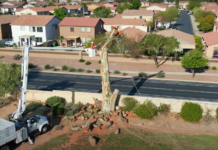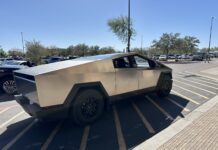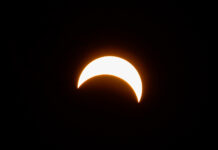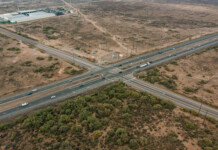During the summer of 1930 many real estate and other private promoters were seeking large cheap acreage listings for speculation and promotion. The Hidden Valley area was a favorite trek for many of these promoters and their clients.
The Arizona Edison Company was in the process of bringing power into Electrical District No. 3 and the 62,000 acres that it covered. Citrus groves and cultivated green alfalfa fields dotted the country in the Hidden Valley area, and that was the stimulus for many enthusiastic land seekers. Dressed in comfortable sports clothes, with freshly washed and shiny cars, the prospective buyers ventured across the hot, dry, dusty desert road, eager to examine what might be the investment of a lifetime.
After exploring the possibilities of Hidden Valley, a stop at Maricopa was a necessity. Many of these travelers did not have the foresight to bring water with them, and the thought of a cool drink at the Maricopa Hotel was most welcome. Frequently, they could be seen resting under a shady tree, or in one of the wide open doors or breezeways of the hotel and restaurant. After the long drive across the reservation from Phoenix, the Maricopa Hotel and the little community of Maricopa were like arriving at an oasis in the desert for these hot, thirsty travelers.
The hotel was the meeting place of the homesteaders in this part of the country, and a popular eating establishment for all freight crews of the railroad. It also served as the trading post for the Papago and Pimas, who traded their mesquite wood for clothing, groceries and other supplies. The store and restaurant never closed. There were three cash registers, and they were kept busy all the time. The homesteader could come in at almost any hour of the day or night and get his mail, supplies or gas.
The owner of the hotel and restaurant, Arthur Deal, worked at one of the cash registers during the peak morning hours when the heaviest freight and passenger customers arrived and were fed. He organized the stock in the store, made out the buying lists, sold a few items, bought some wood, etc. After the regular store clerk from the reservation arrived for work, he was free for the rest of the day. This free time was often taken up by Electrical District meetings or a meeting with the County Engineer or state road officials for the purpose of promoting better roads in the area.
One hot afternoon, M.L. Snapp, a promoter from Phoenix, brought a client to Maricopa to look around. A Phoenix real estate agent told him about cheap land in Maricopa. The men had car trouble on the way to Maricopa and were hot and dusty. They stopped at the railroad station and went into the hotel to get something to drink and cool off. They visited with Art Deal for a while and were finally able to convince him to ride with them out to the Hidden Valley area. The following story is from the words of Art Deal concerning this particular promoter and the Hidden Valley Project:
“We made a quick drive out west and scanned the general locations of some desert land that I thought they might be interested in obtaining, but no progress was made. It was about a week later when Mr. Snapp called me from Phoenix, and asked me to come to see him at his office. He said, ‘Art, I have a buyer for a citrus development if a large enough tract of land can be blocked together. If you can buy the land at ten dollars an acre, I will give you a dollar an acre for every acre you can get under option in one block.’ I accepted his offer and went to work securing the options. That was in June. The blocking was not so easy. When some learned there was a possible buyer, they wanted more money for their land. Most of the land was homesteaded after World War I. Some of it consisted of enlarged homesteads. Others had lived there long enough to become attached to the places even though they could not eat or wear them or make a living off of them. When in difficult circumstances they would offer the land for sale for less than it was really worth. But when a prospective buyer came along, they wanted to raise the price. Others would not sell at any price. A few hoped to benefit by the first development near them.
At last thirty-one hundred acres were under option; four hundred acres in one; six hundred and forty in another, etc. When Mr. Williams, the buyer, came from San Francisco to look over the project, they came to the hotel and picked me up to go with them to work out any last minute plans for putting the land in cultivation. He seemed to have financial backing for a substantial development here in Arizona and was pleased with the prospects. Although it was early June when the option signing was first started, it took until October to finally close the deal.”
“The day that the Hidden Valley Project officially opened, there was a large barbecue given by Mr. Snapp and Mr. Williams. The road had been graded from the Hidden Valley Project to the railroad crossing north about ten miles at Heaton. There were hundreds of cars leaving Phoenix early that day after reading about it in the newspapers. By the evening of the next day, the heavy traffic had stirred up the dust and cut the road so deep, cars could only travel through the soft dirt at slow speed. However, everyone had a good time and seemed enthusiastic that another new and challenging enterprise was started in this area.
Before long, groves of Marsh Seedless grapefruit were set out. A nursery was built and new wells drilled. Mr. Williams brought his family out from San Francisco and the place was humming with activity. Streams of water were flowing down the irrigation ditches. Soon after this the depression hit with all its slowing down results, and we later learned that the desert does not always bloom with the first venture. It usually takes the third or perhaps the fourth owner before they strike “paydirt.”
Photo Courtesy of Arthur Deal Family
Editor’s note: Maricopa factoids will be a regular feature on InMaricopa.com. They are provided by the Maricopa Historical Society, a branch of the Friends of the Maricopa Public Library. Most of the photos and information come from “Reflections of a Desert Town” by author and historical society chairperson Patricia Brock.

















